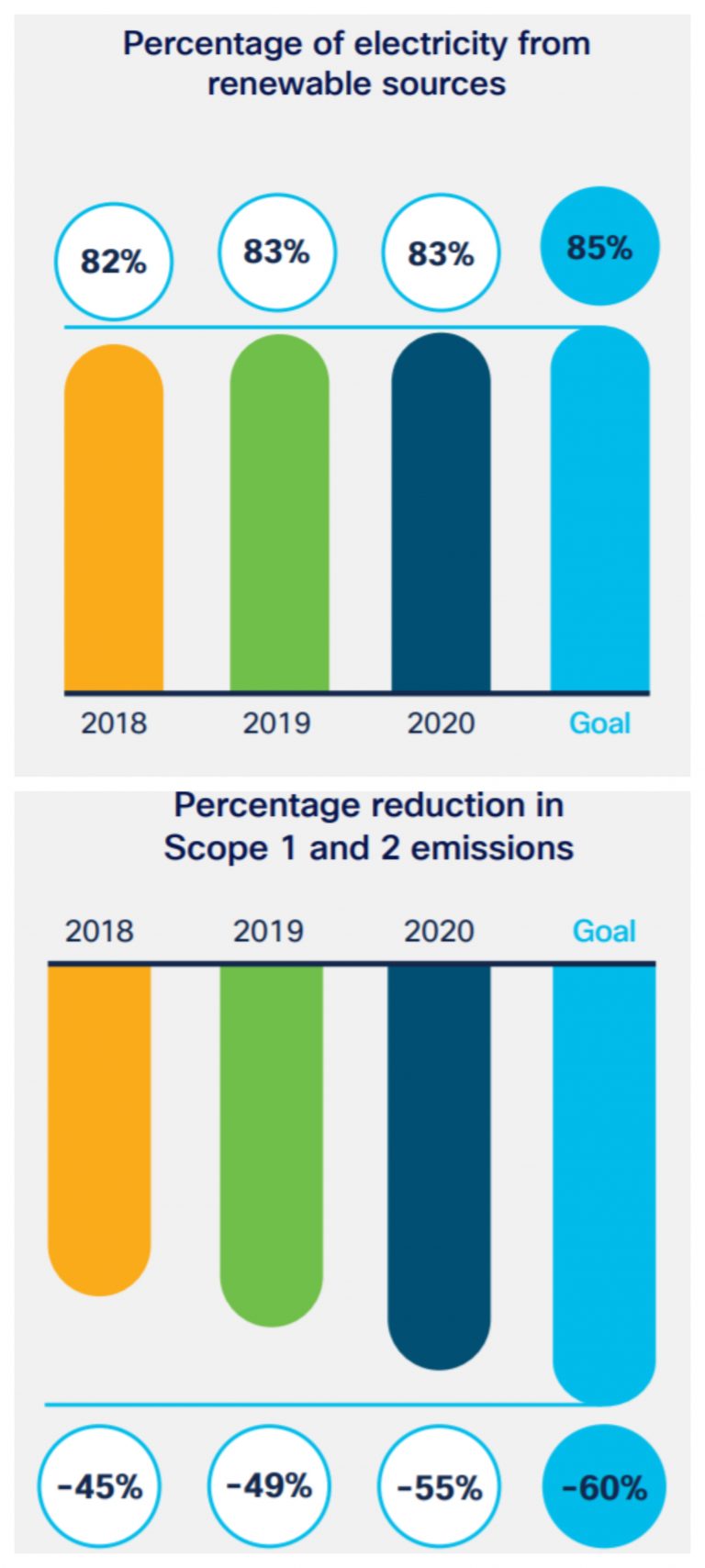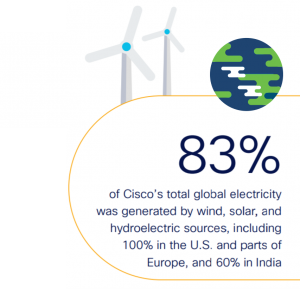Energy and Emissions
 Within Cisco’s direct operations, our main source of emissions is the energy required to operate labs and data centers. We are working toward goals to reduce these Scope 1 and 2 emissions by 60 percent by fiscal 2022 compared to a fiscal 2007 baseline, and to use electricity generated from renewable sources for at least 85 percent of our global electricity by fiscal 2022. As of the end of fiscal 2020, we have reduced emissions by 55 percent, and used electricity generated from renewable sources for 83 percent of our global electricity demand.
Within Cisco’s direct operations, our main source of emissions is the energy required to operate labs and data centers. We are working toward goals to reduce these Scope 1 and 2 emissions by 60 percent by fiscal 2022 compared to a fiscal 2007 baseline, and to use electricity generated from renewable sources for at least 85 percent of our global electricity by fiscal 2022. As of the end of fiscal 2020, we have reduced emissions by 55 percent, and used electricity generated from renewable sources for 83 percent of our global electricity demand.
The unique approach of our Global Energy Management and Sustainability (GEMS) team has driven progress toward achieving our Scope 1 and 2 GHG reduction goals. The GEMS team is responsible for all energy and sustainability initiatives across our 19 million square feet of global real estate. The team operates a holistic program for utilities, energy efficiency, and renewable energy called EnergyOps. This combined approach ensures that our priorities complement, rather than compete with, one another. The team approaches energy and emissions reductions from both ends, reducing energy demand through efficiency projects while increasing our supply of renewable energy. Examples of EnergyOps projects include HVAC system upgrades, airflow management, LED lighting, building controls and analytics, and green building design projects.
In fiscal 2020, the GEMS team completed 44 projects that avoid approximately 19.3 GWh of energy consumption and 8600 metric tonnes CO2e. Over the last five years, we’ve implemented over 440 projects through our EnergyOps program that avoided 140 GWh of energy and 62,000 metric tonnes of CO2e. To meet our fiscal 2022 sustainability goals, the team is investing US$45 million between fiscal 2018 and fiscal 2022 to implement hundreds more efficiency and renewable energy projects.
Focus on renewables
 We’re taking a thoughtful approach to procurement of renewable energy, applying a hierarchy that favors purchases that have the greatest positive impact. Our first priority is to invest in onsite power projects at our facilities, keeping power generation as local as possible. Our second priority is procuring renewable energy from offsite power projects through power purchase agreements (PPAs) or green power utility programs. Among offsite opportunities, we prefer those that are local and add new renewable power to the grid. If onsite and offsite power options are not feasible, we purchase renewable energy credits, sourced from the nation where the energy will be used.
We’re taking a thoughtful approach to procurement of renewable energy, applying a hierarchy that favors purchases that have the greatest positive impact. Our first priority is to invest in onsite power projects at our facilities, keeping power generation as local as possible. Our second priority is procuring renewable energy from offsite power projects through power purchase agreements (PPAs) or green power utility programs. Among offsite opportunities, we prefer those that are local and add new renewable power to the grid. If onsite and offsite power options are not feasible, we purchase renewable energy credits, sourced from the nation where the energy will be used.
In fiscal 2020, Cisco signed our first long-term wind energy PPA, which is our third overall long-term renewable PPA contract. We are sourcing 10 MW of electricity from the Mesquite Star wind farm in Texas, which is helping power our data centers in Richardson and Allen, Texas, supplying approximately 40 percent of Cisco’s electricity consumption in the state.
In addition, we increased our use of renewable energy in India, signing eight short-term (two- to three-year) renewable deals in fiscal 2020. Coupled with two long-term solar deals signed in fiscal 2018, these recent deals will bring our total electricity usage sourced from renewables in all of India to 60 percent. These purchases are particularly significant given that much of India’s power grid still relies on coal and diesel. We’re proud to help contribute to a cleaner national grid while making progress toward our energy and emissions goals.
To learn more about the progress we’re making to power a more inclusive future through CSR, visit our Cisco ESG Reporting Hub, where you can read our CSR Impact Report.



Great work Catherine and team!